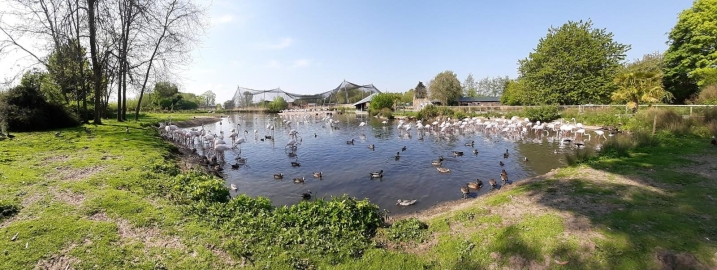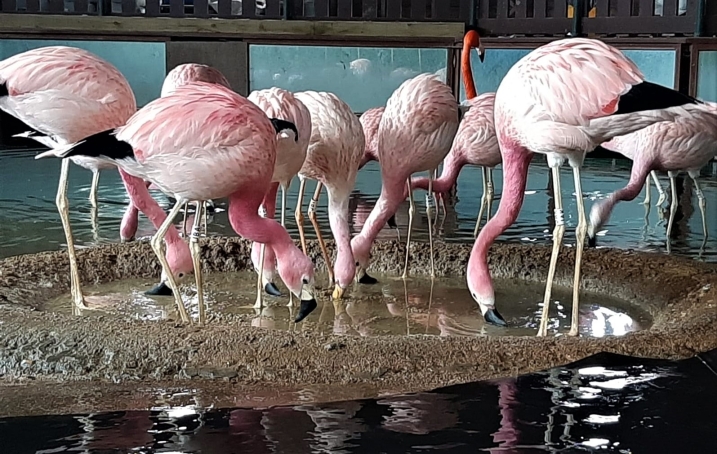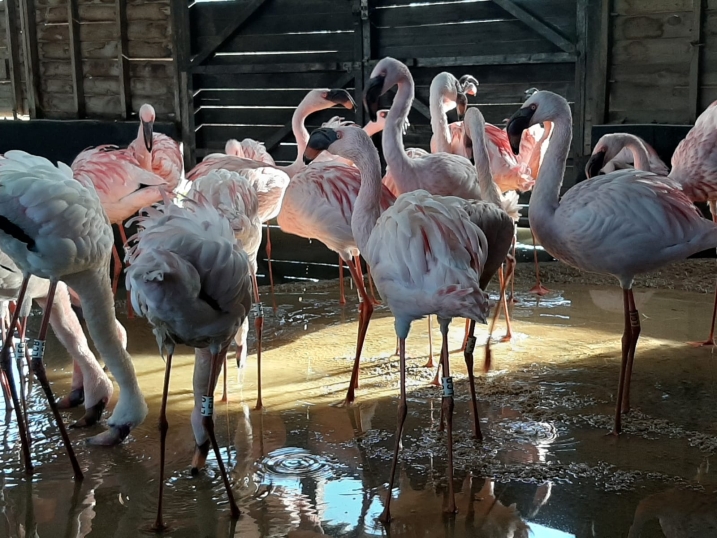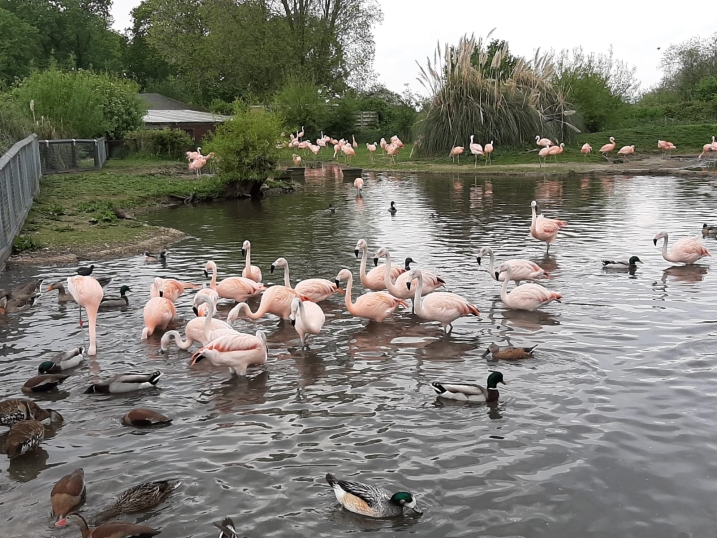Closed but still caring: What's it like looking after a flamingo (or five hundred)?
What's it like to care for the WWT Slimbridge flamingos under lock down? Find out in our behind-the-scenes report with Phoebe, a member of the living collections management team.
Buying in 55 tonnes of flamingo pellet a year, understanding the individual needs of over 500 birds, being an expert in the weather and wind direction to make sure the flamingos don't get chilly, knowing the ins and outs of specialist incubation equipment. It's a demanding job looking after one of the largest groups of flamingos anywhere on the planet. To give you more of an insight into the world of animal care at WWT and to show you a virtual "behind the scenes" of the living collection, this Flamingo Diary features an interview with long-standing aviculturist and fellow WWT-lover, Phoebe Vaughan. I asked her some questions about her time with the pink birds and her career to date with WWT.

Flamingo Diary (FD): How long have you been with WWT?
Phoebe Young (PV): I started at WWT Slimbridge as a volunteer in 2004, during the first year of my degree at university. I became a weekend warden and then a part-time warden until I started working full-time in the WWT Slimbridge Duckery in July 2008.
FD: And what is your current role at WWT Slimbridge?
PV: I am now one of the Deputy Living Collections managers, since August 2019, and so I oversee all of the birds in the living collection under the direction of the Living Collections Manager, Simon. I have always wanted to give to the birds everything in my capacity. Slimbridge has been my calling.
FD: So all the time spent in the WWT Slimbridge Duckery must have made you an expert in managing flamingo eggs, how to incubate and hatch them? Is there a secret to giving flamingo eggs a helping hand at hatching?
PV: Yes and no. We hit a magic recipe that doesn't fail but I can't say why it's better than anything else. I'd say they suit an old fashioned still air incubator best, like our Brinsea Polyhatchers. I think the way they are incubated naturally gives them a temperature gradient and humidity impact, where a forced air incubator could dry them out. When it ain't broke, don't fix it.
FD: It's good to hear that you're such a flamingo fan! What's your favourite thing about them to watch or observe?
PV: Everyone loves to see them display, but my favourite thing is to listen to them eat. I've a method of sitting on a bucket for 30 seconds to a minute in order to get a decent look at their health each day- either close up or with binoculars. I've also got quite good at sliding away and continuing my duties without them caring about what I am doing or where I am going.
FD: So even though there are currently no visitors to see the birds, the constant caring continues as normal. What's your basic day like when you are looking after the flamingos under lock down?
PV: The duty is very fluid. It's more a multiple visit, soaking/ feeding and cleaning session. Ideally the daily flamingo warden needs to check that everyone is well and healthy ASAP so as to get any potential veterinary care to a bird in need straight away. So the first hour is made up of flock visits and checks, soaking the mats in their flamingo house, and giving them a first breakfast if needed. The Andeans, for example, love a cheeky extra breakfast when the ducks are distracted with their feed (photo below from Phoebe).

Then we go round the route again, giving deeper cleans to various houses and matting using high powered pressure washers. We make sure that the water in their exhibits is the perfect level for them to feed, we skim feathers from drains, moisten nest islands, and check that nothing dangerous has fallen into their exhibit. Obviously when we feed we observe the birds to see what they need. For example, the Chileans and Caribbeans are fed in the late afternoon so that they can eat all night, but sometimes we will enrich their day with a bucket of sinking food in their exhibit for them to enjoy. The lessers (see the photo below), Andeans and Mr James get a morning and evening feed, but the greater flamingos are offered food all day long.

We have to adjust their food according to cheeky thieves who want to eat their food, the local weather conditions (such as wind and rain), any disturbance they may have experienced or whether they have spent all day displaying! Most importantly we are continuously attached to our weather apps, because it is the weather forecast that defines how we manage the flocks day-to-day. Some of the houses block northerly winds, others south westerly. Some water bodies freeze easier than others, and some flocks have public pathways closer to them than others. In all honesty, the flamingo wardens need to be flamingo wizards in order to keep everything ticking over. As with all bird keepers, because we can't talk to our birds, we have to learn to read them and that's a real skill with some of our flocks. Reading the vibes of around 300 greater flamingo at one time for example...!
FD: That's a lot of birds to feed! So how much flamingo pellet do you have to lug around?
PV: We are a huge buyer of animal food, with upwards of 500 flamingos on site. We buy about 80 tonnes of a food a year of which around 55 tonnes is flamingo diet. The greater flamingos get three to four sacks per day, the Caribbeans probably one-and-half to two bags, the Chileans one to one-and-a-half and for the lesser flamingos and the same for the Andeans and Mr James, probably half-a-sack to one-and-a-half sacks each group depending on how hungry they are. So that's roughly seven to nine sacks of specialist flamingo pellet every day. The flamingo feed is monotonous but oh so important. Who knows what people are singing to themselves when they have gotten through their third daily hour of pressure washing. Most of the time I just natter away at the birds, goodness knows what the public thinks!
FD: Given that you devote so much energy and time into their care, what do you like most about flamingos generally?
PV: It might sound strange, but I love their age. I love that they have evolved so perfectly for an imperfect environment that they get to get old. I love to know that we can get them to old age. I love their imperfections, their wonky tail feather or their droopy eyelid. I am proud to say WWT has looked after them so well that they get to live a full life.
FD: Ah nice. Old age. My favourite fact too! So do you have a favourite species overall?
PV: It has to be the Andean flamingo? They just make my heart sing. They are so fantastic, but I appreciate that all of the species have their charms. I appreciate them the most when they are having a great time, and most of the times they are having a great time is when we are getting it right.
FD: How would you convince other to love flamingos as much as you? Why become a supporter of WWT and its work with these wonderful birds?
PV: As we look around the world, we see animals that we have grown up with as if they are completely normal; like the giant panda, giraffe, or even flamingos. Pandas fall out of trees, giraffes do the splits to drink, the flamingo can only eat upside down! But then we grow up there is that magical moment where we look at them again and we think to ourselves "just why are you the way you are?" That is what makes the flamingo so cool- they are the new normal. It's great to see so many people who come to WWT fall in love with the flamingos.
WWT has the wetland world at heart, and although we will never be able to contribute to every single thing we'd like to, every donation helps us be the best we can be. People can donate their time by volunteering, by sharing our social media posts to spread the word, they can buy a cup of coffee in our cafes, come to a swan supper or even donate useful household objects. Supporting WWT is both easy and fun, and enriches our lives and those of the birds too.
A great big "thank you" to Phoebe for that amazing insight into the dedicated care that you provide to these wonderful birds. It's great to see how well they are looked after by you and all of your hardworking colleagues. Despite lock down, all of our flamingos are being kept in the best of health (dare I say still in the pink?) and are continuing to receive all of the care and attention that they require from the dedicated living collections team at WWT Slimbridge. In fact, at every WWT centre that houses collection mammals, birds, amphibians and fish, all staff are caring the same as they would do normally for our furry, feathered, scaly or slimy friends.




